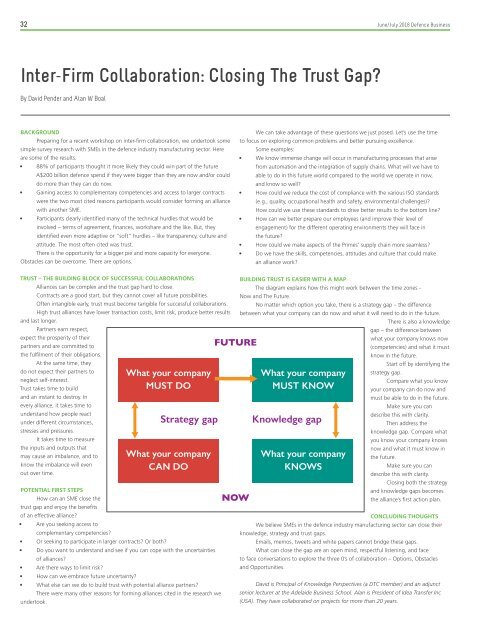Defense Business May-July 2018 Issue
You also want an ePaper? Increase the reach of your titles
YUMPU automatically turns print PDFs into web optimized ePapers that Google loves.
32 June/<strong>July</strong> <strong>2018</strong> Defence <strong>Business</strong><br />
Inter-Firm Collaboration: Closing The Trust Gap?<br />
By David Pender and Alan W Boal<br />
BACKGROUND<br />
Preparing for a recent workshop on inter-firm collaboration, we undertook some<br />
simple survey research with SMEs in the defence industry manufacturing sector. Here<br />
are some of the results.<br />
• 88% of participants thought it more likely they could win part of the future<br />
A$200 billion defence spend if they were bigger than they are now and/or could<br />
do more than they can do now.<br />
• Gaining access to complementary competencies and access to larger contracts<br />
were the two most cited reasons participants would consider forming an alliance<br />
with another SME.<br />
• Participants clearly identified many of the technical hurdles that would be<br />
involved – terms of agreement, finances, workshare and the like. But, they<br />
identified even more adaptive or “soft” hurdles – like transparency, culture and<br />
attitude. The most often cited was trust.<br />
There is the opportunity for a bigger pie and more capacity for everyone.<br />
Obstacles can be overcome. There are options.<br />
We can take advantage of these questions we just posed. Let’s use the time<br />
to focus on exploring common problems and better pursuing excellence.<br />
Some examples:<br />
• We know immense change will occur in manufacturing processes that arise<br />
from automation and the integration of supply chains. What will we have to<br />
able to do in this future world compared to the world we operate in now,<br />
and know so well?<br />
• How could we reduce the cost of compliance with the various ISO standards<br />
(e.g., quality, occupational health and safety, environmental challenges)?<br />
How could we use these standards to drive better results to the bottom line?<br />
• How can we better prepare our employees (and improve their level of<br />
engagement) for the different operating environments they will face in<br />
the future?<br />
• How could we make aspects of the Primes’ supply chain more seamless?<br />
• Do we have the skills, competencies, attitudes and culture that could make<br />
an alliance work?<br />
TRUST – THE BUILDING BLOCK OF SUCCESSFUL COLLABORATIONS<br />
Alliances can be complex and the trust gap hard to close.<br />
Contracts are a good start, but they cannot cover all future possibilities.<br />
Often intangible early, trust must become tangible for successful collaborations.<br />
High trust alliances have lower transaction costs, limit risk, produce better results<br />
and last longer.<br />
Partners earn respect,<br />
expect the prosperity of their<br />
partners and are committed to<br />
the fulfilment of their obligations.<br />
At the same time, they<br />
do not expect their partners to<br />
neglect self-interest.<br />
Trust takes time to build<br />
and an instant to destroy. In<br />
every alliance, it takes time to<br />
understand how people react<br />
under different circumstances,<br />
stresses and pressures.<br />
It takes time to measure<br />
the inputs and outputs that<br />
may cause an imbalance, and to<br />
know the imbalance will even<br />
out over time.<br />
POTENTIAL FIRST STEPS<br />
How can an SME close the<br />
trust gap and enjoy the benefits<br />
of an effective alliance?<br />
• Are you seeking access to<br />
complementary competencies?<br />
• Or seeking to participate in larger contracts? Or both?<br />
• Do you want to understand and see if you can cope with the uncertainties<br />
of alliances?<br />
• Are there ways to limit risk?<br />
• How can we embrace future uncertainty?<br />
• What else can we do to build trust with potential alliance partners?<br />
undertook.<br />
What your company<br />
MUST DO<br />
Strategy gap<br />
What your company<br />
CAN DO<br />
There were many other reasons for forming alliances cited in the research we<br />
FUTURE<br />
NOW<br />
BUILDING TRUST IS EASIER WITH A MAP<br />
The diagram explains how this might work between the time zones -<br />
Now and The Future.<br />
No matter which option you take, there is a strategy gap – the difference<br />
between what your company can do now and what it will need to do in the future.<br />
What your company<br />
MUST KNOW<br />
Knowledge gap<br />
What your company<br />
KNOWS<br />
There is also a knowledge<br />
gap – the difference between<br />
what your company knows now<br />
(competencies) and what it must<br />
know in the future.<br />
strategy gap.<br />
Start off by identifying the<br />
Compare what you know<br />
your company can do now and<br />
must be able to do in the future.<br />
Make sure you can<br />
describe this with clarity.<br />
Then address the<br />
knowledge gap. Compare what<br />
you know your company knows<br />
now and what it must know in<br />
the future.<br />
Make sure you can<br />
describe this with clarity.<br />
Closing both the strategy<br />
and knowledge gaps becomes<br />
the alliance’s first action plan.<br />
CONCLUDING THOUGHTS<br />
We believe SMEs in the defence industry manufacturing sector can close their<br />
knowledge, strategy and trust gaps.<br />
Emails, memos, tweets and white papers cannot bridge these gaps.<br />
What can close the gap are an open mind, respectful listening, and face<br />
to face conversations to explore the three 0’s of collaboration – Options, Obstacles<br />
and Opportunities.<br />
David is Principal of Knowledge Perspectives (a DTC member) and an adjunct<br />
senior lecturer at the Adelaide <strong>Business</strong> School. Alan is President of Idea Transfer Inc<br />
(USA). They have collaborated on projects for more than 20 years.


















